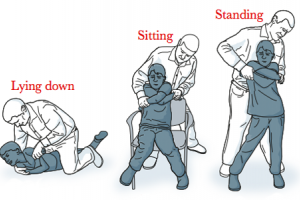 Recently a person posted on Facebook a wish that all children be trained with “positive” methods. The specific Facebook page is run by the largest professional organization of behavior analysts. Comments of that ilk are common along with grandiose promises of behavior analysis as the tool to save the world. I think not. Here’s my reply to that wishful thinking.
Recently a person posted on Facebook a wish that all children be trained with “positive” methods. The specific Facebook page is run by the largest professional organization of behavior analysts. Comments of that ilk are common along with grandiose promises of behavior analysis as the tool to save the world. I think not. Here’s my reply to that wishful thinking.
The Correct Use of Behavior Analytic Terminology:
According to the foundational definitions of behavior analysis, “positive” methods and “negative” methods have fundamentally opposite but symmetrical effects on behavior. If we apply “positive-only” methods to all children it would logically limit the effectiveness of the application. “Positive” methods cannot immediately stop or inhibit behavior, by definition. The logical progression of a “positive only” behavior program is the inability to stop behavior – any behavior.
The thorn on the rose of current cultural norms is that humans have instinctive behaviors that are problematic if not inhibited. Hitting and biting come to mind. Infants are not taught to ball their fists and strike things. They are not taught to bite. They are not taught to take things from others. These behaviors occur in all humans and are developmental. Once displayed, they are influenced by external contingencies. If the child benefits (a positive consequence) from taking another child’s toys the behavior will increase in likelihood and can become a ruling factor in the child’s life. That is positive reinforcement  at work. Theft and robbery are behaviors generated by “positive” influences on behavior. Behavior analysts do not acknowledge that positive reinforcement is the process that strengthens any behavior that is perceived as desired or beneficial from the perspective of the “reinforced”, regardless of its societal value. People who become domineering because of the reinforcing effects of their domination are everywhere. We call them bullies or if adults, thugs. The types of behaviors that create a bully must be inhibited for a human to learn to live in society – but
at work. Theft and robbery are behaviors generated by “positive” influences on behavior. Behavior analysts do not acknowledge that positive reinforcement is the process that strengthens any behavior that is perceived as desired or beneficial from the perspective of the “reinforced”, regardless of its societal value. People who become domineering because of the reinforcing effects of their domination are everywhere. We call them bullies or if adults, thugs. The types of behaviors that create a bully must be inhibited for a human to learn to live in society – but  not totally inhibited. The human must learn when the behavior is appropriate
not totally inhibited. The human must learn when the behavior is appropriate and when it is not. EG: Violence in the protection of innocents or self is rational and ethical. Violence to take from the weak is evil. The current problem with bullying shows how a failure to use “negative” methods can leave innocent people in harm’s way. The bully is protected because of all the “harmful” side-effects of punishment. The innocent is left twisting in the wind because society panders to “positive” methods that cannot inhibit the bullying. The same unethical behaviors that make and perpetuate bullying are ethical if used to suppress the bully.
and when it is not. EG: Violence in the protection of innocents or self is rational and ethical. Violence to take from the weak is evil. The current problem with bullying shows how a failure to use “negative” methods can leave innocent people in harm’s way. The bully is protected because of all the “harmful” side-effects of punishment. The innocent is left twisting in the wind because society panders to “positive” methods that cannot inhibit the bullying. The same unethical behaviors that make and perpetuate bullying are ethical if used to suppress the bully.
For those afflicted with severe mental illness the problem is compounded. As “positive” methods cannot stop behavior, people in treatment facilities hurt themselves and their care-givers. Their violence is unchecked. Those in charge of their care are not allowed to use the behavioral effect known to stop behavior – because of all the “harmful” side-effects. This leaves the primary effects of a violent human to flourish and be a constant danger to the patient and the care-givers. This is a quote from a private communication I received from a BCBA in current practice.
“Here in my current position, I often struggle with years and years of ‘reinforcement’ procedures that still have my students breaking their own noses and requiring 2-person holds – often on a daily basis, and an absolute resistance to even discussing the possibility of using a punishment procedure.”
I don’t think she was making that up. The picture on the right is a cleaned up version of the reality. You will note the absence of blood from the broken nose, spittle, saliva, and the incredible sounds that come out of human mouths tormented by endless restraint for a behavior they cannot control. This raises the question if there is a better way to do it as “positive” methods have no influence on this kind of behavior – and everyone knows it. Here is a quote from Nate Azrin, PhD. His credentials are as impeccable as anyone within behavior analysis.
“Providing negative consequences is the fastest, most effective means of eliminating unwanted behavior. Far faster than developing stimulus control or teaching an alternate behavior. ” (Personal communication)
At the upcoming ABAI conference there will be no presentations about the skilled, rational, ethical, practical use of “negative” ways to inhibit behavior. That is not a fluke. There is no text, instructor, course, certification or credential that would qualify a behavior analyst to use “negative” ways to stop abusive behavior. They do not study it. They oppose it. If someone brings up the logical contradiction of behaviorists ignoring the most powerful primary tool for stopping unacceptable and dangerous behavior because of lesser, side-effects, that person will be strongly opposed and/or attacked. Think about this for a moment. The people who oppose punishment use it against those who disagree with them. The BCBA who wrote the quote above knows that if she pushes discussions of punishment she will ironically suffer ‘negative’ career consequences from her supervisors and colleagues.
Weasel in the Henhouse:
The defense of positive methods leads to some interesting evasions because of obvious contradictions. They claim that they cannot use “negative” means of stopping behavior but routinely use negative means to restrain people but do not provide treatment that will influence future behavior. Meaning the violence and restraint becomes a permanent factor in the person’s life. The restraint does not cause a diminution in the “rate of response” – the primary concept of behavior analysis. The process of restraint often causes physical damage to the individual or those doing the restraining. Behavior analysts refine restraint but not therapy that would reduce the need for it. In most cases they simply strap the person into protective gear and contraptions that limit the damage – but doesn’t stop the behavior. On a behavior practitioner Facebook page recently, these two comments were on the same page with an advertisement for a restraint seminar.
“Hi, I just got a teen client who is highly aggressive and tears at skin (mostly arms, but also necks) with his nails. Does anyone have recommendations for a place to purchase protective equipment?”
“Thanks for accepting me into the group. Looking for suggestions for a client (non-verbal) teen who self abuses (slaps/hits himself in the head causing bruises). Does anyone have any interpositioning techniques Less restrictive than helmets. He hits himself even more when we use interpositioning boards and I’m clueless about what else to try.”
Where is the “positive” solution to these problems? Why do trained behavior analysts need to get protective gear for people if applied behavior analysis is the best tool for behavioral treatment and care?
“They won’t let us use the most effective tools.”
Another disingenuous defense of positive methods is that the public will not allow it and many states have outlawed the use of aversive control in state-run facilities. This is disingenuous because behavior analysts helped make those cultural changes. According to the Association for Behavior Analysis International, their founder, spent a career promoting positive methods and conversely opposing negative methods.
“Throughout his career, Skinner opposed the use of all forms of punishment; he advocated positive ways of changing behavior. ”
If you want to know who helped create the bias toward positive solutions you need look no further. To claim to have an objective view of behavior while attempting to create a biased ideology is best described by the word weasel. The effect on society is devastating. Brutes rule while the innocent suffer. Animals and humans live in life-long struggle, pain and discomfort because effective treatment is banned. Their violence is met by violence in the form of “restraint” if they are in a treatment facility and ignored if they are on the street. The question comes down to this – why do you love the bully but hate the victim? The Hebrew Bible speaks to this issue. “Whoever spares the rod hates their children, but the one who loves their children is careful to discipline them.” (The anti-punishment ideologue will instantly read this to mean that only the rod is used to teach a child – an illogical conclusion. The necessity of using “negative” means to inhibit anti-social behavior does not imply using only that tool for all things. It merely points to the need to inhibit anti-social behaviors. Logically, this form of punishment is self limiting – once the anti-social behavior is gone there is no purpose to using the “rod.” A person who applies aversive control other than than to stop bad behavior would logically be guilty of abuse and would be punished by society.)
If my criticism of favoring bullies seems harsh it is merely because protecting the bully is not acknowledged in context. The bully punishes people but may not be punished. If you do not agree with that conclusion you are still morally obligated to find out what it takes to protect the innocent and discover how to do it correctly. Trust me, “positive” solutions are important in life but cannot control previously reinforced or innate violence. The real answer lies with developing methods that regardless of polarity improve the lives of those who need help and protection. Make up your mind – the bullies and innocents are waiting for your response.
Note: In 1995 I received the coveted Mass Media Award from the Association for Behavior Analysis International. I was the second recipient of the award and it was unsolicited. My point in mentioning that is that I know the language of behavior analysis at a level that allows me to present at their conferences, speak at university psychology departments and teach as an associate professor at a major university. (ASU) I know the literature of their discipline and can cite references that confirm the points I made here. If you are further interested in this topic, I have about 20 blog posts covering this problem in greater depth.

“resistance to even discussing the possibility of using a punishment procedure.”
What would this include? E.i. Electric shocks? Physical paddling?
Brandon, the logical answer is “whatever works”. The Judge Rotenberg Center has many years of data on the process of controlling such behavior. The Association for Behavior Analysis has never supported them. They have been attacked from day one with lawsuits. Last year, the founder, Matt Israel was given a choice of leaving or facing criminal prosecution. The culture will not permit shocking someone to stop them from repeatedly dislodging their retinas by pounding their own eyes. This is ironically the result of behavior analysts conflating the word abuse with punishment. Currently, the standard treatment is simply finer crafted straight jackets and big, husky, trained “bouncers” that wrestle them into submission, day after day. They give webinars and seminars on restraint – but not punishment that could inhibit the behavior.
Take a look at my blog pest entitled, “Would you slap a little girl” – you can find it by typing that into the search box at the top, right of any page of the blog.
Hi Gary,
The Rotenberg Center has a booth every year at ABAI, Matt was there this year talking to everyone and going to sessions. He got an award from ABAI a few years ago. There are a few anti-punishment types in ABAI but the organization is not on record as being “anti.”
Most people find it less and less necessary to use punishment as the speciality area of functional analysis grows stronger. Basically we want to know what the causal variables are and then determine how we can weaken that response and strengthen an incompatible behavior, essentially giving the individual a new history of reinforcement.
JB
Jon, I have to disagree. The Skinnerian bias against aversive control runs deep. If behavior anlaysts were unbiased, your sentence would as logically read, “Most people find it less necessary to use positive reinforcement as the specialty area of functional analysis grows stronger.” Meaning one cannot know which behavioral effect is appropriate without a specific context – unless you prefer one over the other in all cases. This obvious bias exists because the concept that punishment is inherently dangerous permeates the discipline and has since before Skinner wrote Science and Human Behavior. Azrin knew about it before he got to Harvard in the early 50’s.
Now consider that positive reinforcement in the absence of contingent punishment creates most of the evil in the world. Why would anyone prefer the behavioral effect that fueled the Spanish genocidal conquest of the “New World”? I refer to the same behavioral effect that motivates every drug dealer, crack hoe, conqueror, thug, thief and swindler. Why no cautions about that? The conclusion that “nice” is better than “nasty” is derived from normative hedonism. The opposition of using punishment for behavioral reasons while accepting far greater physical damage for medical purposes is the essence of Cartesian Dualism. That is why dangerous, risky, damaging non-therapeutic restraint is promoted, while punishment that would be far less invasive is taboo and would stop the need for restraint. Why are there webinars on restraint that offer CEU’s but none on punishment? The topic is never discussed logically. Of the 1500 or so presentations at the recent ABAI conference, the ratio of presentations of “all other” topics vs. punishment was 1500:1. That is evidence of what Catania suggested on the 50th Anniversary of JEAB.
“Research on human behavior therefore does not seem threatened, but a different topic seems to be in jeopardy. The analysis of aversive control has almost vanished from JEAB. The sole exception in Volume 87 is an article on aversive control with humans, on the effectiveness of restraint as a punisher of stereotyped behavior in autism (Doughty, Anderson, Doughty, Williams, & Saunders, 2007). Has the conduct and publication of research on punishment and escape and avoidance and conditioned suppression and related phenomena been punished? At the least, it has not been much reinforced. It is probably relevant that the links in the initiating chains for such research (Gollub, 1977) have become extended with the interposition of Institutional Review Boards and the corollary requirement that experimental protocols be specified in advance. Could Sidman’s (1958a) tour de force have been conducted in a contemporary laboratory?
The bias was questioned for about 20 years between 1960 and 1980 and then the questioning faded. This is a sign of punishing contingencies that suppressed discussion and research into the topic. The stats don’t lie. There is not a single course, text, instructor, certification or credential that would give a behavior analyst a knowledge of how to use aversive control. How does one become an expert on a topic without training or experience?
Sidman wrote this 25 years ago. Nothing has changed to make it less true, today.
“…competence in the application of punishment is not the mark of a qualified behavior analyst. I know of no training program or degree, whether in psychology, psychiatry, education of behavior analysis that qualifies its recipient to use punishment. ”
What he missed was that he just admitted that he, also, had no credentials or competence that would make him an expert on the topic.
If you read the post carefully then you will understand this comment. The nose-breakers are still breaking their noses, except, perhaps, at JRC. If there was no bias that kind of treatment would be offered anywhere violent, mentally disabled people live their lives being restrained.
Incredibly astute and well written. I am left in awe by how well it’s written though I have intuitively known this to be true for as long as I can remember. It reminds me of a great book written by a Dutch therapist in which she writes how society must recognize childhood trauma in children and offer more help to them and those grown old. She says we need to be soft and sensitive but absolutely employ punishment to those astray, again out of that same show of love. If you’re interested I could translate it for you as it’s a book written in Dutch. Not that I think you would find anything new, but perhaps you’d like to read it.